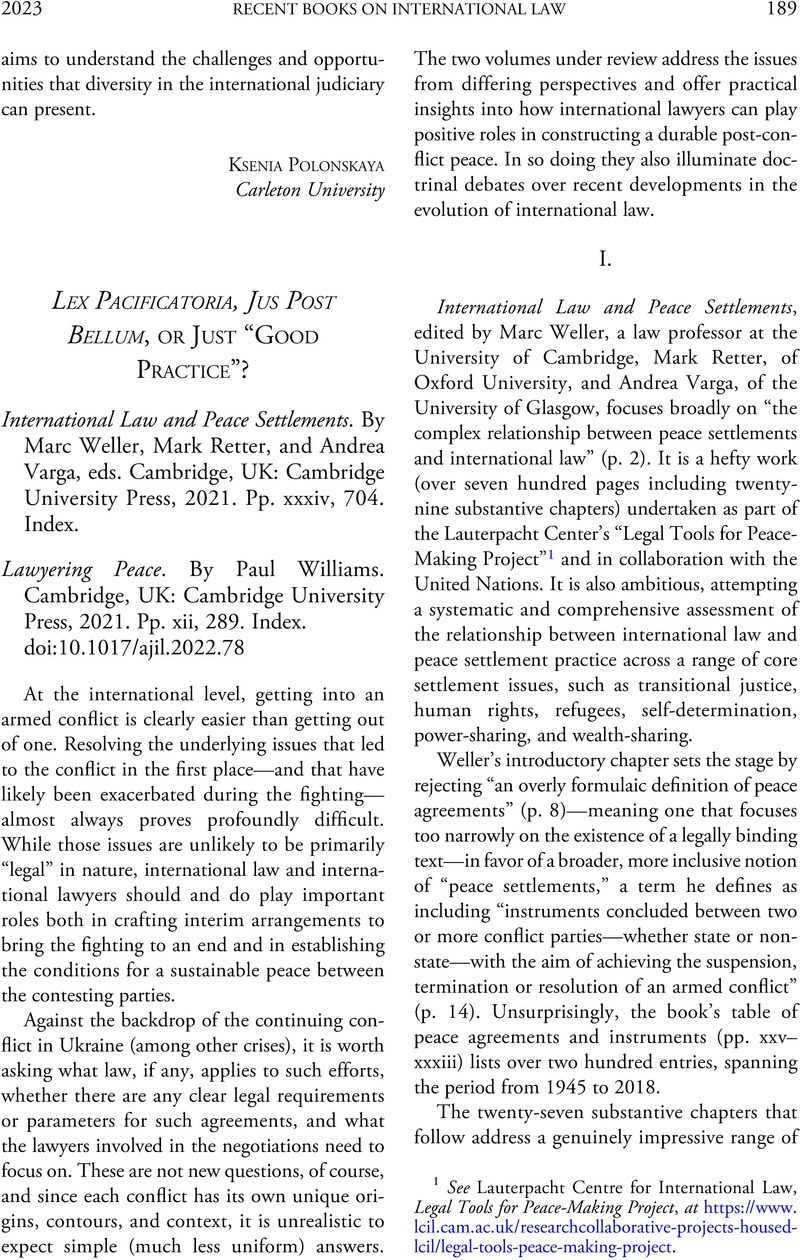No CrossRef data available.
Article contents
Lex Pacificatoria, Jus Post Bellum, or Just “Good Practice”? - International Law and Peace Settlements. By Marc Weller, Mark Retter and Andrea Varga, eds. Cambridge, UK: Cambridge University Press, 2021. Pp. xxxiv, 704. Index. - Lawyering Peace. By Paul Williams. Cambridge, UK: Cambridge University Press, 2021. Pp. xii, 289. Index.
Review products
Published online by Cambridge University Press: 25 January 2023
Abstract

- Type
- Book Reviews
- Information
- Copyright
- Copyright © The Author(s), 2023. Published by Cambridge University Press for The American Society of International Law
References
1 See Lauterpacht Centre for International Law, Legal Tools for Peace-Making Project, at https://www.lcil.cam.ac.uk/researchcollaborative-projects-housed-lcil/legal-tools-peace-making-project.
2 Remarkably, neither book gives attention to the role played by the Conference on Security and Cooperation in Europe (now the OSCE) in negotiating the 1989 Joint Declaration of Twenty-Two States, which has been described as the “[f]inal [p]eace [a]greement” of World War II. See John J. Maresca, The Unknown Peace Agreement (2022).
3 It also recognized jus in bello (the “corpus of the laws and customs of war”), regulating the conduct of parties to an armed conflict, which today is more commonly referred to as the “law of armed conflict” or “international humanitarian law.”
4 See, e.g., James Brierly, The Law of Nations: An Introduction to the International Law of Peace (1928); Hans Kelsen, Peace Through Law (1944); Grenville Clark & Luis B. Sohn, World Peace Through World Law (1958); Leo Gross, International Law and Peace, in Leo Gross, Essays on International Law and Organization (1984); Promoting Peace Through International Law (Cecilia Marcela Bailliet & Kjetil Mujezinovic Larsen eds., 2015); Bailliet, Cecilia M., Peace Is the Fundamental Value that International Law Exists to Serve, 111 ASIL Proc. 308 (2017)Google Scholar.
5 GA Res. 71/189, Annex (Feb. 2, 2017); see also African Charter of Human and Peoples’ Rights, June 27, 1981, Art. 23(1), 21 ILM 58 (1982) (“All peoples shall have the right to national and international peace and security.”); Schabas, William, The Human Right to Peace, 58 Harv. Int'l L.J. Online 28 (2017)Google Scholar, at https://harvardilj.org/2017/04/the-human-right-to-peace.
6 Cf. Henry F. Carey & Rebecca Sims, The International Law of Peace, in Peacebuilding Paradigms: The Impact of Theoretical Diversity on Implementing Sustainable Peace (Henry F. Carey ed., 2020).
7 Robert Kolb, International Law on the Maintenance of Peace: Jus Contra Bellum (2018).
8 See UN Peacekeeping, Terminology, at https://peacekeeping.un.org/en/terminology; see also Sohn, Louis B., The New Dimensions of United Nations Peacemaking, 26 Ga. J. Int'l & Comp. L. 123 (1996)Google Scholar; The Oxford Handbook of Peacebuilding, Statebuilding, and Peace Formation (Oliver P. Richmond & Gëzim Visoka, eds., 2021).
9 Proposed Department of Peacebuilding Act of 2021, H.R.1111, introduced in February 2021 by Rep. Barbara Lee (California) to establish a new executive branch department “dedicated to peacebuilding, peacemaking, and the study and promotion of conditions conducive to both domestic and international peace and a culture of peace.”
10 See Report of the UN Secretary-General, The Rule of Law and Transitional Justice in Conflict and Post-Conflict Societies, UN Doc. S/2004/616 (Aug. 23, 2004).
11 There is extensive literature on the concept. See, e.g., Jus Post Bellum : Mapping the Normative Foundations (Carsten Stahn, Jennifer S. Easterday & Jens Iverson eds., 2014); Larry May & Elizabeth Edenberg, Jus Post Bellum and Transitional Justice (2013); Robert A. Stein, Jus Post Bellum: Justice After the War, 27 Minn. J. Int'l L. 1 (2018); Just Peace After Conflict: Jus Post Bellum and the Justice of Peace (Carsten Stahn & Jens Iversen eds., 2020); Jens Iverson, Jus Post Bellum: The Rediscovery, Foundations, and Future of the Law of Transforming War into Peace (2021); Carina Lamont, International Law in the Transition to Peace: Protecting Civilians Under Jus Post Bellum (2022).
12 See, e.g., Christine Bell, On the Law of Peace: Peace Agreements and the Lex Pacificatoria (2008); Christine Bell, Of Jus Post Bellum and Lex Pacificatoria: What's in a Name?, in Jus Post Bellum : Mapping the Normative Foundations, supra note 11; Bohloulzadeh, Ghassem, The Nature of Peace Agreement in International Law, 10 J. Pol. & L. 208 (2017)Google Scholar; Ozcelik, Asli, Entrenching Peace in Law: Do Peace Agreements Possess International Legal Status, 21 Melb. J. Int'l L. 190 (2020)Google Scholar.
13 See Shelton, Dinah, Normative Hierarchy in International Law, 100 AJIL 291 (2006)CrossRefGoogle Scholar.




